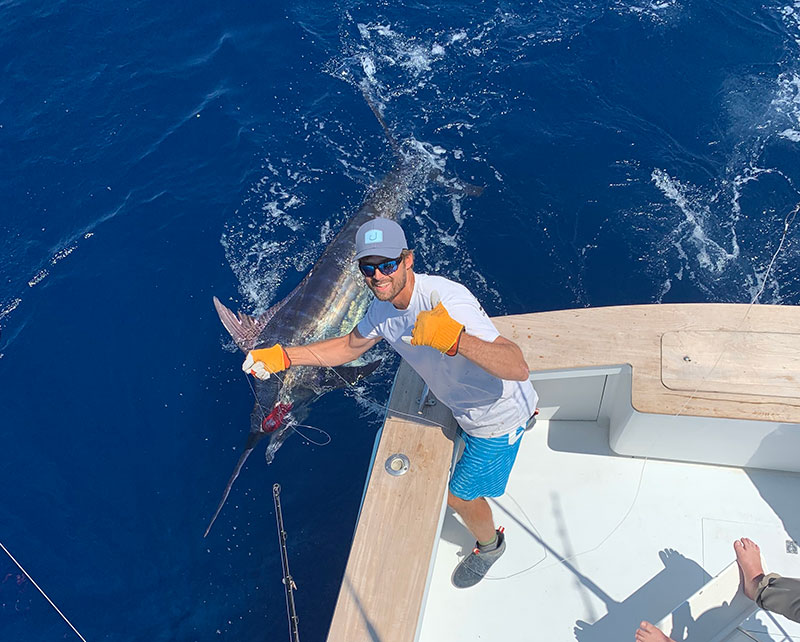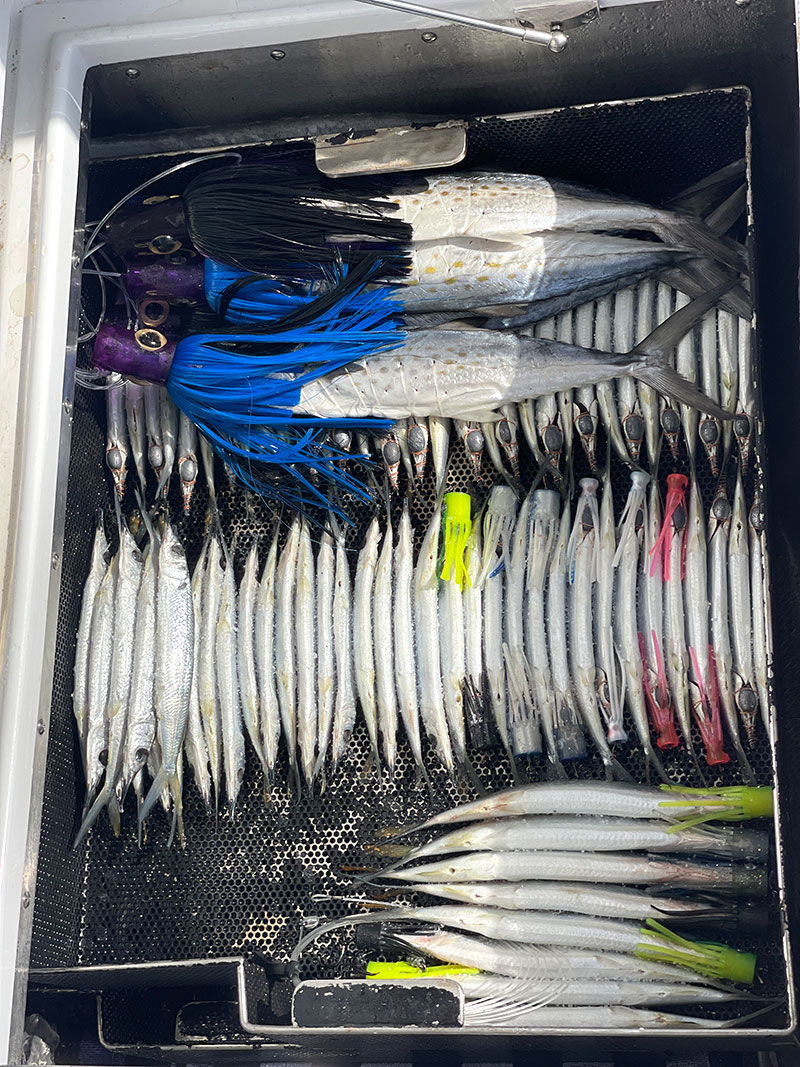
The notorious LaBonte brothers (Ray and Mike) of West Palm Beach introduced me to offshore fishing in South Florida many years ago, when I was in my early twenties. Some years later, on a return trip, Mike and I were dolphin fishing with just the two of us on his center console. At the very moment that this part of the story takes place, Mike was fighting a decent-sized gaffer, and we were simply drifting.
I was standing in the opposite corner of the stern, gaff in hand, with the gaff hook a few feet outboard of the starboard gunwale. Behind me, I heard a splash, and a split second later, the gaff got heavy. It happened very fast, but somehow, I was able to keep my grip on the gaff, and in one fluid motion, swung another gaffer into the boat, completely independent of the one that Mike was still hooked into. The fish had jumped in exactly the right place, at the right time, and landed on the gaff hook, impaling itself in the side.
Completely green, the fish flopped around and tail whipped Mike between his legs before I managed to kick him into a fish box. Despite now being in a moderate amount of pain, Mike kept working on his fish, and we added that to the ice shortly as well. To this day, looking back at the literally thousands of dolphins I have put in a fish box (or released in certain locales), on a wide range of boats, that is the only one I have seen that caught itself.
Don’t wait
The first trip I ever made offshore in South Florida with Ray and Mike taught me something that adapted well to center console fishing in the Carolinas. What I didn’t know about the ocean down there prior to that trip was just how productive the water can be within a mile of the inlet. Where you generally run from 30 to 60 miles from most Carolina inlets to find offshore pelagic species, you can just about catch them from the rocks at Boynton Inlet if the wind is right.
Within 5 minutes of running on that first trip, Ray started screaming. “Put something in the water! Get something in the water! Anything with a hook in it!”
At first, I thought he was joking. Then I looked at the bottom machine and realized that we were already in 50 fathoms.
Mike cut the throttle back to trolling speed and tossed me a TLD 25 which was already rigged with a smallish lure, with the (razor sharp) hook cranked tight on one of the reel harness lugs. So, I fired it out there, and he did the same thing from the other corner. Again, I wasn’t quite sure if I was being had or not, but I kept quiet. Within 30 seconds, the rod in Mike’s corner bent and the reel started screaming. An instant later, the rod I had deployed had a fish hooked up as well. It was almost too easy.
Ray told me later that he had just seen a few baitfish jump out of the corner of his eye, and that was what inspired his tantrum. Sure enough, it paid off with two gaffers to start. Seeing as we only caught five in the entire day, him spotting a quick flash of “fishy” water, and his brother having rigs ready to fire out, made for a good chunk of our collective success.
Anticipate action

What I learned from this was simple. If you are ready to rumble when you come across a good opportunity to bend a rod, you have a high probability of a successful trip. If you’re not ready when that opportunity presents itself, regardless of what species you are targeting, you run a high risk of blowing that chance. Fish don’t tend to hang around and wait for you to get your game face on. They live in an ever-changing environment, and they are one part of the food chain. Preparedness is key.
I do think that the improvements in technology have made us less prepared in some ways as fishermen. Better charts and more accurate chart plotters have made a good many offshore fishermen orient their fishing toward GPS waypoints rather than reacting to what they see. Vastly improved sonar units give a much better picture of the water column. But if you spend all day staring at a scope, you might be missing what’s on top of the water. That floating timber, covered in sargassum weed, might be the key to filling the box. When you run across dolphinfish Shangri-La 10 miles inshore of where you thought you were going to start fishing, what do you have on board that’s ready to hook a fish? Do you have sharp hooks ready to go in the water, or did you think you “still had time?”
Every charter boat in the marina in the Carolinas, along with most private boats, used to have a cooler in the stern. The cooler housed a bait tray, and those trays were completely filled with rigged ballyhoo and coils of leaders. This concept still exists but has dwindled.
Rather than snapping entire leaders on with snap swivels, most of the fleet has shifted to fishing wind-on leaders almost exclusively. Baits are rigged when it’s time to fish. Wind on leaders have proven their worth time and time again, especially for tunas. But getting a spread in the water takes a bit more time than it previously did when you have to rig a fresh bait each time you deploy. It may be a better idea to hedge your bets, and at the very least, keep a tray full of dink ballyhoo rigs, or some sea witch/ballyhoo rigs on No. 9 piano wire ready to snap on and go for when you find that grass mat in an unexpected part of the ocean.
As I experienced that one day in West Palm, you certainly can catch dolphin on lures, and there’s nothing easier to throw out quickly.
Another thing I learned from my South Florida experiences is that live bait is never a bad call. Don’t believe me? Take the time one morning to sabiki up a few dozen live cigar minnows and cast a few just shy of an active weed line. Tell me what happens next. By the way, a 20 plus pound dolphinfish on a big spinning rod is a ton of fun. Just don’t reel against the drag when the fish wants to run.
Regardless of where you live, or how far you run to find fish, offshore fishing isn’t cheap. You have a ton of capital tied up in your boat, tackle, and fuel. Even more valuable is the time you spend prepping and cleaning up after a trip. That time is much more well spent when its productive. Sometimes it’s just as simple as knowing exactly when to put hooks in the water and how quickly you can execute exactly that.
Be prepared, always:
No matter how much you’ve prepared for a day on the water, if you’re not ready for the unexpected, you’ll miss out on some prime opportunities. Have something ready to cast at a moment’s notice and you’ll be rewarded often enough.




Be the first to comment